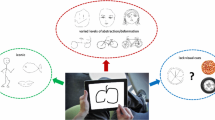Abstract
Most of existing sketch recognition methods focus on the contour/shape of whole sketches. They ignore different granularities of sketches during sketching. Stroke sequences of sketches often demonstrate the change of various granularities. In the progress of sketching, a coarser-grained contour gradually changes to a finer-grained object. Different granularities of sketch imply different levels of semantic information and play different roles in sketch recognition. In this paper, a transfer-deep-learning-based sketch recognition method--“sketch-transfer-net” is proposed. Sketch-transfer-net designs a novel fine-tuning strategy to use different granular sketches to fine-tune different layers of neural network. The extensive comparative experiments show that the proposed sketch-transfer-net can capture descriptive information of various granular sketches and therefore improve the performance of sketch recognition. In addition, the novel fine-turning strategy could weaken the negative effect in transfer learning and enable CNNs to be well trained on small sketch datasets.





Similar content being viewed by others
References
Alex K, Ilya S, Hinton GE (2012) Imagenet classification with deep convolutional neural networks. In: Advances in neural information processing systems, pp 1097–1105
Bonilla EV, Chai KMA, Williams CKI (2007) Multi-task Gaussian process prediction[C]. In: Conference on neural information processing systems. Vancouver. British Columbia, Canada
Cao X, Zhang H, Liu S, Sym-fish GX (2013) A symmetry-aware flip invariant sketch histogram shape descriptor. In: Computer vision (ICCV), 2013 IEEE international conference on. IEEE, pp 313–320
Carneiro G, Jepson AD (2004) Pruning local feature correspondences using shape context[C]. In: Proceedings of the 17th international conference on pattern recognition. IEEE Computer Society Press, Los Alamitos, pp 16–19
Dalal N, Triggs B (2005) Histograms of oriented gradients for human detection[C]. In: 2005 IEEE computer society conference on computer vision and pattern recognition. San Diego, CA, USA, pp 886–893
Eitz M, Hildebrand K, Boubekeur T, Alexa M (2011) Sketch-based image retrieval: benchmark and bag-of-features descriptors[J]. IEEE Trans Vis Comput Graph 17(11):1624–1636
Eitz M, Hays J, Alexa M (2012) How do humans sketch objects?[J]. ACM Trans Graph 31(4):44–54
Evgeniou T, Pontil M (2004) Regularized multi-task learning[C]. In: Proceedings of the tenth ACM SIGKDD international conference on knowledge discovery and data mining. Seattle, Washington, USA, pp 109–117
Finkel JR, Manning CD (2010) Hierarchical Bayesian domain adaptation[C]. In: Human language technologies: conference of the north American chapter of the Association of Computational Linguistics. Boulder, Colorado, pp 602–610
Glorot X, Bordes A, Bengio Y (2011) Deep sparse rectifier neural networks[C]. In: Proceedings of the 14th international conference on artificial intelligence and statistics. MIT Press, Nevada, pp 315–323
Goodfellow IJ, Wardefarley D, Mirza M, Courville A, Bengio Y (2017) Maxout networks[OL]. http://arxiv.org/abs/1302.4389v4
Klare B, Li Z, Jain AK (2011) Matching forensic sketches to mug shot photos[J]. IEEE Trans Pattern Anal Mach Intell 33(3):639–646
Lecun Y, Boser B, Denker JS, Henderson D, Howard RE, Hubbard W, Jackel LD (1989) Backpropagation applied to handwritten zip code recognition[J]. Neural Comput 1(4):541–551
Li Y, Song YZ, Gong S (2013) Sketch recognition by ensemble matching of structured features. In: British machine vision conference (BMVC), pp 35.1–35.11
Li Y, Hospedales TM, Song YZ, Gong S (2015) Free-hand sketch recognition by multi-kernel feature learning[J]. Comput Vis Image Underst 137(8):1–11
Long M, Wang J, Ding G, Cheng W, Zhang X, Wang W (2012) Dual transfer learning. In: Proceedings of SIAM international conference on data mining (SDM), Anaheim, USA, pp 1947–1961. (SDM 2012)
Long M, Wang J, Ding G, Shen D, Yang Q (2012) Transfer learning with graph co-regularization. Twenty-sixth AAAI conference on artificial intelligence, pp 1033–1039
Lowe DG (2004) Distinctive image features from scale-invariant keypoints[J]. Int J Comput Vis 60(2):91–110
Schneider RG, Tuytelaars T (2014) Sketch classification and classification-driven analysis using fisher vectors[J]. ACM Trans Graph 33(6):174–183
Seddati O, Dupont S, Mahmoudi S (2015) Deepsketch: deep convolutional neural networks for sketch recognition and similarity search. In: Content-based multimedia indexing (CBMI), 2015 13th international workshop on. IEEE, pp 1–6
Simonyan K, Zisserman A (2017) Very deep convolutional networks for large-scale image recognition[OL]. http://arxiv.org/abs/1409.1556
Srivastava N, Hinton GE, Krizhevsky A, Sutskever I, Salakhutdinov R (2014) Dropout: a simple way to prevent neural networks from overfitting[J]. J Mach Learn Res 15(1):1929–1958
Szegedy C, Liu W, Jia Y, Sermanet P, Reed S, Anguelov D, Erhan D, Vanhoucke V, Rabinovich A (2014) Going deeper with convolutions. arXiv preprint arXiv:1409.4842
Wang F, Kang L, Li Y (2015) Sketch-based 3d shape retrieval using convolutional neural networks[C]. In: Proceedings of the 2015 IEEE conference on computer vision and pattern recognition. IEEE Computer Society Press, Los Alamitos, pp 1875–1883
Weiss K, Khoshgoftaar TM, Wang DD (2016) A survey of transfer learning[J]. Journal of Big Data 3(1):9
Yang Y, Hospedales TM (2015) Deep neural networks for sketch recognition. arXiv preprint arXiv:1501.07873v1
Yesilbek KT, Sen C, Cakmak S, Sezgin TM (2015) SVM-based sketch recognition: which hyperparameter interval to try? In: Proceedings of the workshop on sketch-based interfaces and modeling. Eurographics Association, pp 117–121
Yu Q, Yang Y, Song YZ, Xiang T, Hospedales TM (2017) Sketch-a-net that beats humans[OL]. http://arxiv.org/abs/1501.07873v3
Acknowledgments
This work is supported by National Natural Science Foundation of China (Grant Nos. 61602004) to Dr. Zhao, Natural Science Foundation of the Education Department of Anhui Province (Grant No. KJ2016A041, KJ2017A011), and in part supported by NSF CNS-1305302 and Texas State Research Enhancement Program grant to Dr. Lu.
Author information
Authors and Affiliations
Corresponding author
Additional information
Publisher’s note
Springer Nature remains neutral with regard to jurisdictional claims in published maps and institutional affiliations.
Rights and permissions
About this article
Cite this article
Zhao, P., Liu, Y., Lu, Y. et al. A sketch recognition method based on transfer deep learning with the fusion of multi-granular sketches. Multimed Tools Appl 78, 35179–35193 (2019). https://doi.org/10.1007/s11042-019-08216-6
Received:
Revised:
Accepted:
Published:
Issue Date:
DOI: https://doi.org/10.1007/s11042-019-08216-6




